Scratch BottleBat 3.0 Original Design / Scratch Built
Scratch - BottleBat 3.0 {Scratch}
Contributed by Larry Brand
| Manufacturer: | Scratch |
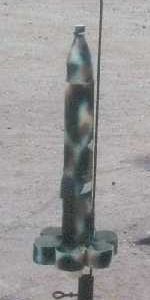
Brief:
I have scaled down the "BottleBat" tubefin rocket I presented a few
of months ago in Sport Rocketry magazine from 4" diameter to
3" diameter. This allows it to be constructed from the more available
3" postal mailing tubes. Cost is well under 10 dollars for a L1 capable
sport rocket that goes together in a couple of hours and flies on any 50-150N
motor from AT F50-4 to Ellis Mountain I134-10.
Construction:
Construction of the 3" version is the same as its big brother. You can see
the Winter 2005 Sport Rocketry article for the specifics. Materials
include:
- 1 36" postal mailing tube, the ones with the thin colored plastic waterproof coating are best for strength and painting
- 1 14" x 38mm rocketry motor tube
- 2 3" x 38mm centering rings, 1/8" plywood
- 2 standard vending machine size soft drink bottles
- 1/4" launch lug tube (3" long)
- 1 24" to 30" nylon chute, mine was an old Vaughn Bros. 28"
- 8' of parachute cord for shock cord

Construction is generic tubefin rocket except for the cheap plastic bottle nosecone, and I used 5 minute epoxy throughout the build.
- Cut a 19.5" section for the body and 6 x 2" sections for the tube fins from the postal tube. I used an ultra-fine hacksaw blade in a miterbox to do this.
- Glue the 6 tube fins around the base of the body tube 2 at a time in self-jigging tubefin fashion. The fins should be glued to each other as well as to the body.
- Glue the centering rings 3/4" from each end of the motor tube.
- Install the motor tube assembly into the rocket body with plenty of epoxy.
- Cut two 3/4" pieces from the remaining postal tube stock. Cut a 1" wide section out of one of these (to reduce its diameter so it fits into the body tube) and with a liberal amount of epoxy, slide it down into the top of the body tube until it contacts the upper centering ring to lock the motor mount in place.
- Now do the same with the other 3/4" section of postal tube, but this time only slide it 3" down into body tube. Its purpose is to form a rest for the shoulder of the "bottle cone". (You can skip this step if you decide to ruin your BottleBat 3.0 by giving it a "normal" 3" plastic ogive nose cone.)
- Construction of the "bottle cone":
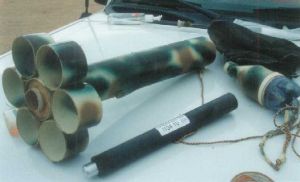
- Drink the contents of the 2 bottles.
- Cut the base off one bottle with a razor saw or X-Acto blade about 2" from the bottom.
- With ample epoxy, glue this "doubler" to the bottom of the intact bottle.
- Drill two 1/8" holes in the bottom of the reinforced bottle about 1" apart.
- Hook a piece of coat hanger through these holes, twist the ends together tightly, cover the coat hanger with Duct tape or solder if so inclined. This is the shock cord attachment ring.
- You can add ballast if desired (100g advised for the Ellis Mountain motor) into a piece of scrap tubing that fits into the mouth of the bottle, so don't glue the cap on. Or you can just dump some sand inside the bottle.
- Wrap masking tape until a snug fit with the body tube is achieved about 2 3/4" from the base of the bottle. The base of the bottle cone should rest on the ring you installed earlier as a "stop".
- Attach the recovery system to the coat hanger loop. I used 8' of para cord with a 28" nylon chute. A 30" Top Flite X-chute is another good choice.
- The anchor for the shock cord is a loop made from 7" of para cord knotted in a ring. Pass this loop through a 1/8" hole made in the body tube 5" from the top, cover the exposed knot with a piece of a plastic cigar tube or a bisected 18mm nose cone as a fairing. Just fill with epoxy and push over the knot. This is a modification of the LOC system that has never failed me.
- The launch lug tube is applied directly above one of the triangular "holes" between the tube fins. The "safe" CG to use is 3" above the tube fin can (for 1 caliber CG is actually even lower than this). So you can see how a foot long motor like an Ellis H50 or I134 actually improves the balance of a tubefin rocket! CP is somewhere down in the fin can area.
Finishing:
Finish was with Testor's spray in about 5 colors as I attempted a
"camo" paint job. It came out looking like a CBU-something cluster
bomb, and it is hard to find in the desert, so I'm not doing this paint job
anymore.

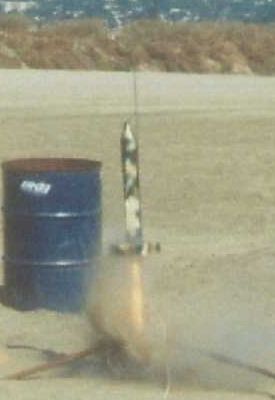
Flight:
It has excellent flight characteristics just like its big brother. BottleBat
3.0 has been flown on the following motors/delays: AT F50-4 and G80-4, CTI
H143SS-6 and G69-5, Ellis Mountain H50-6, H101-8 and I134-10. Flights on these
H motors was in the 1300-1700' range, so it makes for a very convenient and
cheap Level 1 rocket that anybody can build, even right at the field. Top
performance was on the Ellis I134-10 motor, one of my favorites, which went to
2673' as measured by the Perfectflite MicroAlt (I fly the altimeter in a
taped-on
"parasite
pod" since there is no payload bay). Note in the photo how this huge
motor fits in the BottleBat 3.0 with really no ballast needed (I snuck in 100g
for insurance). The neatest flight was on the H101-8 as I finally caught a
launch shot with shock diamonds in the exhaust flame. BottleBat 3.0 has the
high drag flight characteristics of all tube fins, but not as bad as you'd
think. I measured minimum Cd using several different motors and it came out to
be only 1.23, which is pretty darn good for a tubefin and "only"
about 50% more drag than for a "normal" 4FNC rocket with a
"normal" nose cone.
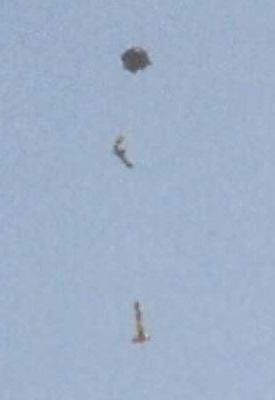
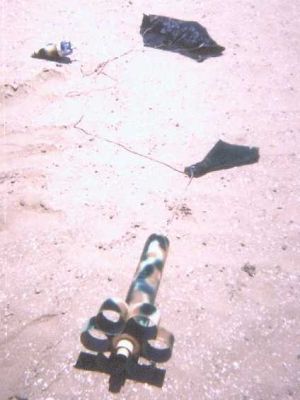
Summary:
PROs: Low cost fun flying L1 cert rocket. Easy and fast to scratch build.
Doesn't go too high, so you can fly H-I power in small field sites without
busting the waiver or losing it in the boondocks. It is very sturdy and safe
due to the impact absorbing nose cone. It is also a very wind and gust
resistant design.
CONs: It is a tube fin rocket, so performance is in the toilet. It is not very attractive, but these designs grow on you after a while and they're just fun to fly and experiment with. There are no tears it you lose it as the parachute costs much more than the $8-$10 rocket.
Sponsored Ads
 |
 |











